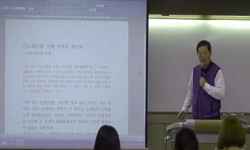원작 소설의 무대화는 곧 장르의 변화를 의미하기 때문에 각색 단계에서 내러티브변용 뿐만 아니라 표현 방식에도 함께 살펴볼 필요가 있다. 소설에서 뮤지컬로의 매체 전환은 1차원에서 3...
http://chineseinput.net/에서 pinyin(병음)방식으로 중국어를 변환할 수 있습니다.
변환된 중국어를 복사하여 사용하시면 됩니다.
- 中文 을 입력하시려면 zhongwen을 입력하시고 space를누르시면됩니다.
- 北京 을 입력하시려면 beijing을 입력하시고 space를 누르시면 됩니다.
소설 『웃는 남자』의 뮤지컬 전환 연구 : 서사 방식과 시·청각의 변용을 중심으로 = A Study on the Transformation from Novel to Musical of <The Man Who Laughs> ; A focus on the narrative style and the transformation of the visual and the auditory
한글로보기https://www.riss.kr/link?id=T16816666
- 저자
-
발행사항
서울 : 동국대학교 영상대학원, 2023
-
학위논문사항
학위논문(석사) -- 동국대학교 영상대학원 , 문화콘텐츠학과 콘텐츠기획 , 2023. 8
-
발행연도
2023
-
작성언어
한국어
- 주제어
-
DDC
306
-
발행국(도시)
서울
-
형태사항
119 p. ; 26 cm
-
일반주기명
지도교수: 이종대
-
UCI식별코드
I804:11020-000000086528
- DOI식별코드
- 소장기관
-
0
상세조회 -
0
다운로드
부가정보
국문 초록 (Abstract)
원작 소설의 무대화는 곧 장르의 변화를 의미하기 때문에 각색 단계에서 내러티브변용 뿐만 아니라 표현 방식에도 함께 살펴볼 필요가 있다. 소설에서 뮤지컬로의 매체 전환은 1차원에서 3차원으로의 변형이기 때문에 결국 언어적 표현의 시·청각화가 핵심이라고 할 수 있다. 그런 의미에서 본 연구에서는 우선 소설과 뮤지컬이 상이한 특징이 존재함에도 불구하고 문학 소설이 지속적으로 뮤지컬로 변용되는 까닭을 밝히고, 이것이 어떤 방식으로 각색이 이뤄지는지 살펴보고자 한다. 이에 본 연구에서 가장 핵심으로 여기고 있는 시·청각적 요소의 변용에 특히 주목하고자 한다.
이에 따라 본 논문은 연구 대상으로 소설 『웃는 남자』와 뮤지컬 <웃는 남자>로 선정했으며, 소설 『웃는 남자』에서 뮤지컬 <웃는 남자>로 변용되는 과정에서 시·청각적 요소의 변화를 통해 작품의 메시지와 의미를 어떻게 녹이고 구현되었는지를 살펴보았다.
연구 방법은 다음과 같다. 우선 매체 전환과 각색에 관련된 선행연구 및 문헌 조사를 통해 매체 전환의 개념과 유형, 각색의 의미와 방식을 알아보았다. 이후 뮤지컬의 시·청각적 요소가 수용되는 방법을 분석하기 위해 소설과 뮤지컬의 차이점과 뮤지컬만이 가지는 시·청각적 구성요소에 대해 정리하여, 이를 토대로 ‘뮤지컬의 시·청각적 변용 연구’를 위한 관점을 확립하였다. 이러한 이론적 정립을 바탕으로 소설 『웃는 남자』를 뮤지컬 <웃는 남자>로 매체 전환 시 소설이 뮤지컬로 어떻게 변용되어 나타났는지 서사 방식과 시·청각적 변용을 중심으로 비교 분석하였다.
연구 결과 뮤지컬 <웃는 남자>는 원작 소설의 서사를 최대한 활용하여 뮤지컬로 전환한 점과 소설의 주제와 메시지를 뮤지컬의 다양한 시·청각적 요소를 통해 충실하게 구현한 점, 더불어 현대적 관점에서 대중들이 모두 공감할 만한 보편적 욕망인 ‘행복’의 주제를 더하여 상징적이고 함축적으로 무대에 구현하였음을 알 수 있었다.
다국어 초록 (Multilingual Abstract)
When the original novel gets transformed into a stage production, the genre changes. Therefore, it is necessary to look at not only the change in narrative, but also the way to express the media in the adaptation stage. In other words, visualizatio...
When the original novel gets transformed into a stage production, the genre changes. Therefore, it is necessary to look at not only the change in narrative, but also the way to express the media in the adaptation stage.
In other words, visualization and audioization of the linguistic expression are the key of the media transition from novel to musical because it is a transformation from one dimension to three dimensions. This raises questions about why literary novels are continuously transformed into musicals even with the different characteristics of novels and musicals, how novels are being arranged for the stages, and how visual and auditory elements are being used during the arrangement.
Accordingly, this paper selected the novel "The Man Who Laughs" and its musical counterpart for research. This research analyzed and examined how the meaning of the message was conveyed and how perfectly it was implemented mainly based on the visual and auditory elements in the transformation process. The research stages are as follows. The concepts and the types of media transformation and the meanings and the methods of the adaptation through preceding research and literature research related to media transformation and adaptation.
In order to analyze how the visual and auditory elements of musicals are adapted, the differences between novels and musicals and the visual and auditory components of musicals were summarized in this paper. Based on this, a perspective for the study of visual and auditory transformation of musicals was established. This paper compared and analyzed how the novel "The Man Who Laughs" was converted into a musical, focusing on the narrative techniques and the visual and auditory transformation, based on the theoretical concept and perspective established in the earlier stage of this study.
As a result of the study, the novel "The Laughing Man" was arranged into a musical symbolically and implicitly by getting the best of the original novel's narrative, implementing the novel's theme and message through various visual and auditory elements, and adding ‘happiness’ as its theme, which is a general desire of people in the modern perspective.
목차 (Table of Contents)
- Ⅰ. 서론
- 1. 연구 배경과 목적 1
- 2. 연구 대상과 방법 4
- 3. 선행연구 8
- Ⅱ. 이론적 배경
- Ⅰ. 서론
- 1. 연구 배경과 목적 1
- 2. 연구 대상과 방법 4
- 3. 선행연구 8
- Ⅱ. 이론적 배경
- 1. 매체 전환과 각색 14
- 1) 매체 전환의 개념과 유형 14
- 2) 각색의 의미와 방식 18
- 3) 소설을 매체 전환한 뮤지컬 사례 22
- 2. 소설과 뮤지컬의 특성 25
- 1) 소설과 뮤지컬의 장르적 차이 25
- 2) 뮤지컬의 시청각적 요소 30
- Ⅲ. 소설 웃는 남자와 뮤지컬 <웃는 남자>의 표현 비교
- 1. 빅토르 위고의 웃는 남자 34
- 1) 빅토르 위고의 세계관 34
- 2) 소설 웃는 남자의 개요 37
- 2. 소설 웃는 남자와 뮤지컬 <웃는 남자>의 서사 방식 차이 40
- 1) 선형 구조와 동시 구조 40
- 2) 서술자의 유무와 서사 방식 44
- 3) 문자 언어와 이미지 언어 49
- 3. 소설에서 뮤지컬 <웃는 남자>로의 시청각의 변용 54
- 1) 시각적 요소 55
- 2) 청각적 요소 90
- Ⅳ. 소결 106
- Ⅴ. 결론 110
- 참고문헌 113
- ABSTRACT 118












